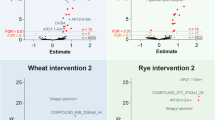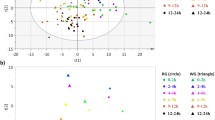Abstract
Purpose
Alkylresorcinols (AR) are phenolic lipids present in the bran of wheat and rye. Plasma AR and their urinary metabolites may be suitable biomarkers of whole-grain (WG) wheat and rye consumption. The objective of this study was to examine plasma AR and urinary AR metabolites in response to WG wheat consumption.
Methods
In a randomized crossover study, 19 subjects (10 males, 9 females; BMI 22.0 kg/m2; age 26 years) incorporated either 3 servings (48 g) or 6 servings (96 g) of WG wheat daily into their regular diet for 1 week. Subjects completed a 2-week washout period, abstaining from all WG consumption, before each intervention. Fasting blood and 24-h urine were collected before and after each intervention. Plasma AR homologues (C19:0, C21:0, C23:0) were quantified by GC–MS after diethyl ether and solid phase extraction and derivatization. Urinary AR metabolites [3,5-dihydroxybenzoic acid and 3-(3,5-dihydroxyphenyl)-propanoic acid] were determined using HPLC with electrochemical detection after enzymatic deconjugation and ethyl acetate extraction.
Results
Urinary total AR metabolites were significantly higher after 6 compared with 3 servings of WG wheat (56 vs. 32 μmol/day, P < 0.001). This dose–response relationship was independent of age, sex, energy intake, and baseline urinary AR metabolite concentration. Plasma total AR tended to be higher after 6 compared with 3 servings of WG wheat (103.0 vs. 86.9 nmol/L), but this difference was not significant (P = 0.42).
Conclusion
The results suggest that urinary AR metabolites from 24-h urine collections may be useful as biomarkers of compliance in intervention studies of WG wheat.

Similar content being viewed by others
References
Jonnalagadda SS, Harnack L, Liu RH, McKeown N, Seal C, Liu S, Fahey GC (2011) Putting the whole grain puzzle together: health benefits associated with whole grains—summary of American Society for Nutrition 2010 Satellite Symposium. J Nutr 141(5):1011s–1022s. doi:10.3945/jn.110.132944
Ye EQ, Chacko SA, Chou EL, Kugizaki M, Liu S (2012) Greater whole-grain intake is associated with lower risk of type 2 diabetes, cardiovascular disease, and weight gain. J Nutr 142(7):1304–1313. doi:10.3945/jn.111.155325
Ross AB, Shepherd MJ, Schupphaus M, Sinclair V, Alfaro B, Kamal-Eldin A, Aman P (2003) Alkylresorcinols in cereals and cereal products. J Agric Food Chem 51(14):4111–4118. doi:10.1021/jf0340456
Ross AB, Kochhar S (2009) Rapid and sensitive analysis of alkylresorcinols from cereal grains and products using HPLC-Coularray-based electrochemical detection. J Agric Food Chem 57(12):5187–5193. doi:10.1021/Jf900239t
Ross AB, Kamal-Eldin A, Lundin EA, Zhang JX, Hallmans G, Aman P (2003) Cereal alkylresorcinols are absorbed by humans. J Nutr 133(7):2222–2224
Linko AM, Juntunen KS, Mykkanen HM, Adlercreutz H (2005) Whole-grain rye bread consumption by women correlates with plasma alkylresorcinols and increases their concentration compared with low-fiber wheat bread. J Nutr 135(3):580–583
Linko AM, Parikka K, Wahala K, Adlercreutz H (2002) Gas chromatographic-mass spectrometric method for the determination of alkylresorcinols in human plasma. Anal Biochem 308(2):307–313
Landberg R, Kamal-Eldin A, Aman P, Christensen J, Overvad K, Tjonneland A, Olsen A (2011) Determinants of plasma alkylresorcinol concentration in Danish post-menopausal women. Eur J Clin Nutr 65(1):94–101. doi:10.1038/ejcn.2010.193
Zhu Y, Shurlknight KL, Chen X, Sang S (2014) Identification and pharmacokinetics of novel alkylresorcinol metabolites in human urine, new candidate biomarkers for whole-grain wheat and rye intake. J Nutr 144(2):114–122. doi:10.3945/jn.113.184663
Ross AB, Aman P, Kamal-Eldin A (2004) Identification of cereal alkylresorcinol metabolites in human urine-potential biomarkers of wholegrain wheat and rye intake. J Chromatogr B Anal Technol Biomed Life Sci 809(1):125–130. doi:10.1016/j.jchromb.2004.06.015
Koskela A, Linko-Parvinen AM, Hiisivuori P, Samaletdin A, Kamal-Eldin A, Tikkanen MJ, Adlercreutz H (2007) Quantification of alkylresorcinol metabolites in urine by HPLC with coulometric electrode array detection. Clin Chem 53(7):1380–1383. doi:10.1373/clinchem.2006.084764
Marklund M, Strömberg EA, Lærke HN, Bach Knudsen KE, Kamal-Eldin A, Hooker AC, Landberg R (2014) Simultaneous pharmacokinetic modeling of alkylresorcinols and their main metabolites indicates dual absorption mechanisms and enterohepatic elimination in humans. J Nutr 144(11):1674–1680
Landberg R, Aman P, Hallmans G, Johansson I (2013) Long-term reproducibility of plasma alkylresorcinols as biomarkers of whole-grain wheat and rye intake within Northern Sweden Health and Disease Study Cohort. Eur J Clin Nutr 67(3):259–263. doi:10.1038/ejcn.2013.10
Ross AB (2012) Present status and perspectives on the use of alkylresorcinols as biomarkers of wholegrain wheat and rye intake. J Nutr Metab. doi:10.1155/2012/462967
Landberg R, Linko AM, Kamal-Eldin A, Vessby B, Adlercreutz H, Aman P (2006) Human plasma kinetics and relative bioavailability of alkylresorcinols after intake of rye bran. J Nutr 136(11):2760–2765
Landberg R, Aman P, Friberg LE, Vessby B, Adlercreutz H, Kamal-Eldin A (2009) Dose response of whole-grain biomarkers: alkylresorcinols in human plasma and their metabolites in urine in relation to intake. Am J Clin Nutr 89(1):290–296. doi:10.3945/ajcn.2008.26709
Marklund M, Landberg R, Andersson A, Aman P, Kamal-Eldin A (2013) Alkylresorcinol metabolites in urine correlate with the intake of whole grains and cereal fibre in free-living Swedish adults. Br J Nutr 109(1):129–136. doi:10.1017/s0007114512000621
Drake I, Sonestedt E, Gullberg B, Bjartell A, Olsson H, Adlercreutz H, Tikkanen MJ, Wirfalt E, Wallstrom P (2014) Plasma alkylresorcinol metabolites as biomarkers for whole-grain intake and their association with prostate cancer: a Swedish nested case–control study. Cancer Epidemiol Biomark Prev 23(1):73–83. doi:10.1158/1055-9965.epi-13-0878
Ross AB, Bourgeois A, Macharia HN, Kochhar S, Jebb SA, Brownlee IA, Seal CJ (2012) Plasma alkylresorcinols as a biomarker of whole-grain food consumption in a large population: results from the WHOLEheart Intervention Study. Am J Clin Nutr 95(1):204–211. doi:10.3945/ajcn.110.008508
Kristensen M, Toubro S, Jensen MG, Ross AB, Riboldi G, Petronio M, Bugel S, Tetens I, Astrup A (2012) Whole grain compared with refined wheat decreases the percentage of body fat following a 12-week, energy-restricted dietary intervention in postmenopausal women. J Nutr 142(4):710–716. doi:10.3945/jn.111.142315
Ross AB, Bruce SJ, Blondel-Lubrano A, Oguey-Araymon S, Beaumont M, Bourgeois A, Nielsen-Moennoz C, Vigo M, Fay LB, Kochhar S, Bibiloni R, Pittet AC, Emady-Azar S, Grathwohl D, Rezzi S (2011) A whole-grain cereal-rich diet increases plasma betaine, and tends to decrease total and LDL-cholesterol compared with a refined-grain diet in healthy subjects. Br J Nutr 105(10):1492–1502. doi:10.1017/s0007114510005209
Magnusdottir OK, Landberg R, Gunnarsdottir I, Cloetens L, Akesson B, Onning G, Jonsdottir SE, Rosqvist F, Schwab U, Herzig KH, Savolainen MJ, Brader L, Hermansen K, Kolehmainen M, Poutanen K, Uusitupa M, Thorsdottir I, Riserus U (2013) Plasma alkylresorcinols reflect important whole-grain components of a healthy Nordic diet. J Nutr 143(9):1383–1390. doi:10.3945/jn.113.175588
Ross AB (2012) Analysis of alkylresorcinols in cereal grains and products using ultrahigh-pressure liquid chromatography with fluorescence, ultraviolet, and CoulArray electrochemical detection. J Agric Food Chem 60(36):8954–8962. doi:10.1021/jf301332q
Marklund M, McKeown NM, Blumberg JB, Chen CYO (2013) Hepatic biotransformation of alkylresorcinols is mediated via cytochrome P450 and β-oxidation: a proof of concept study. Food Chem 139(1–4):925–930. doi:10.1016/j.foodchem.2013.01.122
Landberg R, Townsend MK, Neelakantan N, Sun Q, Sampson L, Spiegelman D, van Dam RM (2012) Alkylresorcinol metabolite concentrations in spot urine samples correlated with whole grain and cereal fiber intake but showed low to modest reproducibility over one to three years in U.S. women. J Nutr 142(5):872–877. doi:10.3945/jn.111.156398
Guyman LA, Adlercreutz H, Koskela A, Li L, Beresford SA, Lampe JW (2008) Urinary 3-(3,5-dihydroxyphenyl)-1-propanoic acid, an alkylresorcinol metabolite, is a potential biomarker of whole-grain intake in a U.S. population. J Nutr 138(10):1957–1962
Eastwood MA (1992) The physiological effect of dietary fiber: an update. Annu Rev Nutr 12:19–35. doi:10.1146/annurev.nu.12.070192.000315
Ross AB, Chen Y, Frank J, Swanson JE, Parker RS, Kozubek A, Lundh T, Vessby B, Aman P, Kamal-Eldin A (2004) Cereal alkylresorcinols elevate gamma-tocopherol levels in rats and inhibit gamma-tocopherol metabolism in vitro. J Nutr 134(3):506–510
Marklund M, Landberg R, Andersson R, Aman P, Kamal-Eldin A (2012) Alkylresorcinol metabolism in Swedish adults is affected by factors other than intake of whole-grain wheat and rye. J Nutr 142(8):1479–1486. doi:10.3945/jn.112.159244
Marklund M, Stromberg EA, Hooker AC, Hammarlund-Udenaes M, Aman P, Landberg R, Kamal-Eldin A (2013) Chain length of dietary alkylresorcinols affects their in vivo elimination kinetics in rats. J Nutr 143(10):1573–1578. doi:10.3945/jn.113.178392
Montonen J, Landberg R, Kamal-Eldin A, Aman P, Knueppel S, Boeing H, Pischon T (2010) Reliability of fasting plasma alkylresorcinol concentrations measured 4 months apart. Eur J Clin Nutr 64(7):698–703. doi:10.1038/ejcn.2010.71
Kulawinek M, Jaromin A, Kozubek A, Zarnowski R (2008) Alkylresorcinols in selected Polish rye and wheat cereals and whole-grain cereal products. J Agric Food Chem 56(16):7236–7242. doi:10.1021/jf801707g
Aubertin-Leheudre M, Koskela A, Marjamaa A, Adlercreutz H (2008) Plasma alkylresorcinols and urinary alkylresorcinol metabolites as biomarkers of cereal fiber intake in Finnish women. Cancer Epidemiol Biomark Prev 17(9):2244–2248. doi:10.1158/1055-9965.epi-08-0215
Aubertin-Leheudre M, Koskela A, Samaletdin A, Adlercreutz H (2010) Plasma and urinary alkylresorcinol metabolites as potential biomarkers of breast cancer risk in Finnish women: a pilot study. Nutr Cancer 62(6):759–764. doi:10.1080/01635581003693058
Marklund M, Landberg R, Aman P, Kamal-Eldin A (2011) Comparison of gas chromatography-mass spectrometry and high-performance liquid chromatography with coulometric electrode array detection for determination of alkylresorcinol metabolites in human urine. J Chromatogr B Anal Technol Biomed Life Sci 879(9–10):647–651. doi:10.1016/j.jchromb.2011.01.034
Landberg R, Man P, Kamal-Eldin A (2009) A rapid gas chromatography-mass spectrometry method for quantification of alkylresorcinols in human plasma. Anal Biochem 385(1):7–12. doi:10.1016/j.ab.2008.10.031
Andersson A, Marklund M, Diana M, Landberg R (2011) Plasma alkylresorcinol concentrations correlate with whole grain wheat and rye intake and show moderate reproducibility over a 2-to 3-month period in free-living Swedish adults. J Nutr 141(9):1712–1718. doi:10.3945/jn.111.139238
Ross AB, Becker W, Chen Y, Kamal-Eldin A, Aman P (2005) Intake of alkylresorcinols from wheat and rye in the United Kingdom and Sweden. Br J Nutr 94(4):496–499
Acknowledgments
The authors’ responsibilities were as follows: NMM, AHL, and PFJ contributed to the study concept and analysis design; ABR, MM, KAL, JBB, and CYC contributed to data acquisition; JM and MM performed the statistical analysis; MM, CYC, and NMM contributed to the interpretation of data; JBB and CYC conducted the blood AR analysis, and MM conducted the analysis of urinary AR metabolites; ABR analyzed the AR in the food; HR designed the metabolic diets; NMM, MM, and KAL drafted the manuscript, and all authors were involved in critical revision and had final approval of the manuscript. We thank Dustin Burnett for his assistance in the initial design of the metabolic diet and Dr. Robert Moreau for initial analysis of the AR content of the food. The authors also acknowledge the cooperation of study participants and the Metabolic Research Unit and Nutrition Evaluation Laboratory staff at the Human Nutrition Research Center on Aging at Tufts University. This study was supported by grants from the General Mills Bell Institute of Health and Nutrition and a grant from the USDA Agricultural Research Service (agreement 58-1950-0-014).
Conflict of interest
NMM is supported by a grant from the General Mills Bell Institute of Health and Nutrition. ABS is an occasional consultant for the Nestlé Food and Beverage Company, work which is not related to the present article. PFJ is a member of the Bay State Milling Nutrition Science Advisory Council. The other authors declare no conflicts of interest.
Ethical standard
Written informed consent was obtained from all subjects prior to study enrollment. The study was reviewed and approved by the Tufts University Health Sciences Campus Institutional Review Board and performed in accordance with the ethical standards laid down in the 1964 Declaration of Helsinki and its later amendments.
Author information
Authors and Affiliations
Corresponding author
Electronic supplementary material
Below is the link to the electronic supplementary material.
Rights and permissions
About this article
Cite this article
McKeown, N.M., Marklund, M., Ma, J. et al. Comparison of plasma alkylresorcinols (AR) and urinary AR metabolites as biomarkers of compliance in a short-term, whole-grain intervention study. Eur J Nutr 55, 1235–1244 (2016). https://doi.org/10.1007/s00394-015-0936-8
Received:
Accepted:
Published:
Issue Date:
DOI: https://doi.org/10.1007/s00394-015-0936-8




